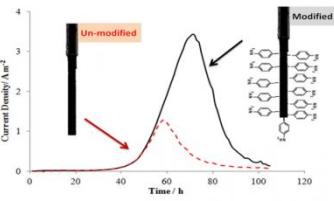Sep 5 2013
A team of researchers in Ireland have found evidence that altering the chemistry of an electrode surface (surface engineering) can help microbial communities to connect to the electrode to produce more electricity (electron-exchange) more rapidly compared to unmodified electrodes.
 This shows wiring microbes to conduct and produce electricity faster. (Credit: Amit Kumara)
This shows wiring microbes to conduct and produce electricity faster. (Credit: Amit Kumara)
Electron exchange is at the heart of all redox reactions occurring in the natural world, as well as in bioengineered systems: so called 'biolectrochemical systems'. Practical applications of these systems include current generation, wastewater treatment, and biochemical and biofuel production. The microbial-electrode interface is a sum of complex physical-chemical and biological interactions permitting microbes to exchange electrons with solid electrodes to produce bioelectrochemical systems. In these systems the microbes, compete, and self-select electrode materials for electron exchange capabilities. However, to date this selection is not well understood yet electricity or chemicals can be produced using various substrates, including wastewater or waste gases, depending upon operational settings, says Amit Kumar, who worked under the leadership of Dónal Leech at the National University of Ireland Galway in Ireland. The Biomolecular Electronics Research Laboratory has been working on probing conditions for selection of electrodes by microbes for several years, and we have recently adopted an approach to tailor the chemistry of electrode surfaces which will help us better understand the selection mechanism says Amit Kumar and Dónal Leech. Our first result shows that surfaces modified with nitrogen-containing amines result in higher and more rapid production of current, compared to those without this modification, when placed in microbial cultures.
Next on our researcher agenda is to elucidate the selection mechanism using a range of surface modifications and microbial cultures.
Press release avilable from http://www.eurekalert.org/